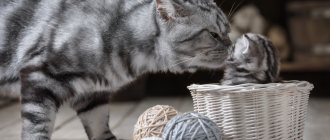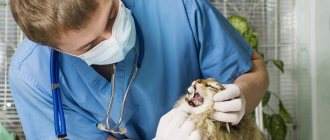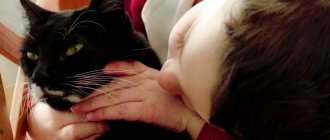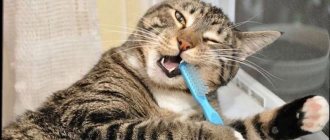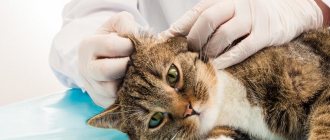- Lethargy of the animal.
- Refusal of food and water.
- Prolonged bouts of vomiting.
- Continuous diarrhea.
- Constipation.
- Signs of intestinal obstruction.
- The cat does not have any alarming symptoms associated with swallowing the bag, but it does have internal diseases that you are aware of.
You can’t hesitate and rely on the fact that the cat will feel better! When visiting a medical veterinary institution, the animal will undergo a set of procedures that will help determine the degree of danger and determine further treatment actions. The cat should have an ultrasound, x-ray or study with a contrast agent. Polyethylene is dangerous with the risk of developing severe intestinal obstruction. Situations when surgical intervention are necessary are not uncommon. Rehabilitation after surgery is quite difficult and lengthy.
Another difficult moment for a cat is anesthesia . If there are concomitant diseases (heart, stomach, liver, kidneys), doctors do not give any guarantees and in the postoperative period you should rely only on the cat’s strength. Also at risk are cats whose age exceeds 7 years. The situation can be significantly aggravated by a late visit to the clinic and a high risk of developing intestinal tissue necrosis.
Most likely, the pet will be prescribed maintenance therapy and a special diet. If you value your pet and wish him a full recovery, doctors’ recommendations should be followed completely and without making independent adjustments.
Should you worry?
Cats are extremely inquisitive creatures, so they can often find sausage wrappers, New Year's rain, plastic and other objects in their mouths that are not intended for consumption. Veterinarians note that if the piece of the bag is small, then swallowing it should not cause any harm to the pet’s body. It will pass naturally after a few days along with the stool, without causing complications.
In the wild, representatives of the cat family consume non-dietary fiber, with the help of which it is possible to cleanse the gastrointestinal tract. That is why their habit of consuming foreign objects should not alarm owners. However, it is better to avoid such a situation. If the owner notices that the kitten is beginning to be partial to the bags, it is recommended to provide him with grass, soft bones, or purchase special dry industrial complementary foods.
What to do if a cat eats feces on the ground?
Feces are often eaten by kittens, as well as anxious, sick and old cats.
They can also “feast” on the earth. Such a “dish” is primarily dangerous due to infection with parasites, especially if it is soil or feces of unknown origin (not from your cat). Therefore, if you notice this behavior in your pet, perform an emergency anthelmintic, get tested for protozoa and review the animal’s diet. Separately, it is necessary to say about the land. Soil from a flower pot may contain dangerous fertilizers, chemicals or toxic plant secretions. Soil poisoning is quite rare, but if you suspect that the soil has been contaminated, it is better to show your cat to a doctor.
Consequences: is it dangerous?
Even if the pet swallowed a small piece of the bag, the symptoms described above indicate the occurrence of intestinal obstruction. If timely help is not provided, the problem can even lead to death.
The owner should not ignore the appearance of vomiting in the animal after the incident.
If a cat has eaten a piece of polyethylene, it is mostly eliminated from the body without outside help, but there are also situations when swallowing the bag causes complications. When the owner notices that a pet has consumed polyethylene, it is important to monitor its condition for several days. When no changes are observed in it, there is no reason to panic. However, if an animal has eaten a plastic bag and exhibits the following symptoms, it is important to contact a veterinarian as soon as possible:
- anxiety;
- constipation;
- increase in abdominal size;
- inappropriate behavior when trying to touch the peritoneum;
- loss of appetite;
- constant vomiting;
- diarrhea;
- weakness and apathy.
To worry or not
Representatives of the cat family in natural conditions tend to “cleanse” the stomach and intestines with inedible objects. Therefore, you should not be surprised when your pet begins to show an unhealthy interest in Christmas tree “rain”, plastic bags or packaging for meat and fish products.
Wrong diet.
Most often, this phenomenon indicates that the cat is simply hungry or lacks the vitamins that it is trying to obtain in such a unique way.
In this case, you can start feeding your furry pet with specialized food, sprouted grass or soft chicken bones.
If changing the diet does not help and the cat continues to eat inedible objects, you should carefully observe changes in his behavior and condition. Even a small piece of polyethylene that gets into the stomach of an animal can cause a stop or slowdown in the movement of feces through the intestines with simultaneous blockage of its lumen (coprostasis) and intestinal obstruction.
Other reasons. The following may indicate the tabby's fascination with inedible packaging:
- stress – eating bags helps the animal get rid of the discomfort;
- intestinal diseases, toothache or oral problems.
Separately, it should be noted that a piece of polyethylene can get into the stomach during play or even in order to attract the owner’s attention. If the piece eaten was small, smaller in size than a matchbox, most likely there is no cause for concern; it will come out on its own with feces or vomit within a few hours. If this does not happen or the package is not all out, and the pet’s condition begins to deteriorate, this is a reason to immediately contact a veterinarian.
What to do?
In this situation, the doctor may consider it necessary to perform an ultrasound on the animal.
When visiting a veterinary clinic, the doctor will send the cat for an ultrasound and x-ray. Using these techniques, it is possible to identify the location of the package and determine the state of the pet’s body. If necessary, radiography is performed using a contrast agent. In some situations, ingestion of the package causes necrosis of intestinal tissue. If this condition has been diagnosed, surgical intervention is mandatory. It is unsafe in elderly animals and in the presence of concomitant diseases. If the results of the examination did not reveal intestinal obstruction and the bag does not injure the internal organs, the veterinarian often prescribes a diet that helps quickly safely remove polyethylene from the body along with feces.
Recommendations for the owner to help prevent the problem
To prevent a situation where a cat has eaten cellophane, it is important not to throw away bags of fish, meat and other products that may attract the attention of a pet to places inaccessible to it. It is better to equip the trash can with a lid and put it in a closet that will close tightly. These recommendations also apply to New Year's rain and tinsel. If a cat likes to conquer the Christmas tree, you need to decorate it at a level that the pet does not reach. In addition, you can also use repellent sprays, which are sold at the pet store. They have a specific aroma that four-legged pets do not like.
You can prepare a similar composition yourself. The owner of the prankster will need to use water and citrus essential oil. Cats prefer to avoid places that smell strongly. The prepared composition should be poured into a spray bottle and sprayed where it is better for the pet not to appear. At the same time, spraying the prepared product on the animal is strictly prohibited. The liquid can get into the cat's visual organs and cause vision impairment.
What to do if your cat ate a crocus?
Eating indoor and garden plants and the owner's bouquets is one of the cat's favorite pastimes. And, unfortunately, it is quite risky, since many potted and cut flowers are poisonous to animals.
The most dangerous for cats are all bulbous plants (tulips, crocuses, irises, lilies), all euphorbias, crushed seeds of some rosaceous plants (apricot, plum, apple, peach, etc.), as well as aloe, kalanchoe, monstera, aconite, delphinium and many others. Bulbous plants poison even the water in which they stand, so most often tragic cat poisonings are associated with them.
If you see that your cat is chewing any indoor, garden or bouquet plant, urgently check the lists of poisonous vegetation, and if you find yours there, immediately run to the veterinarian. In most cases, the count is in minutes and hours.
To avoid this, isolate bouquets from the cat, and distribute all dangerous indoor plants to friends.
Hunting instinct
Modern bathrooms have ventilation. It creates a light breeze. The tip of the roll sways and rustles barely audibly. Cats have very sensitive hearing. They catch this rustling sound.
At this moment, the animal’s hunting instinct turns on. A cat is a predator, and it tends to react to every sound and the slightest movement. He attacks the roll and tears the paper. You perceive it as a bad habit. But for cats this behavior is quite natural when hunting.
Women in the life of Mark Bogatyrev from “Beryozka”: from a simple girl to an actress
I bought furniture from IKEA and made an amazing designer cabinet out of it.
All my friends are jealous: my husband made a bright and stylish wardrobe for his wife from the attic
What to do if a cat ate a thread?
Any inedible object eaten by a cat threatens it with two dangers - intestinal obstruction and perforation. If a cat has eaten a non-sharp, small or biodegradable object (a piece of paper, a raw bone, a fruit seed, a coin, a button, a cotton swab, etc.), then most likely it will come out on its own naturally.
Immediate medical attention is required if a cat swallows string tape (the intestines can collect on them), boiled bones, needles, pins, tinsel, other foil products (intestinal perforation), as well as any large quantities of objects, including litter (intestinal obstruction). If you get to the veterinarian in time, then everything can be done with endoscopic removal of the object from the stomach, if not, you cannot do without surgery.
To the question “what to do if the cat ate something wrong,” there is only one answer - show it to the veterinarian. It definitely won’t be unnecessary, and in many cases a timely visit to the clinic can save a cat’s life!
The cat needs paper litter
Pets may be attracted to the soft texture of toilet paper. My friend thinks that paper or newspaper litter is best for her cat's litter box. This material is warm and soft, it does not create unnecessary noise and dust.
It is possible that the litter tray you have chosen is not suitable for your pet. Many cats do not like wood pellets and pebbles, as they are quite hard and noisy materials. Therefore, animals tend to use toilet paper as litter.
In this case, this problem can be easily resolved. Simply replace the wood or stone filler with pieces of newspaper or soft paper.
Preventive measures
If a kitten or cat appears in your house, then you need to know what to do so that it does not eat the fish along with the cellophane.
- Do not throw away the skins of sausages, sausages, bags in which fish or meat was stored in places accessible to the cat. Keep trash bags out of your cat's reach. To prevent your cat from eating the skin of a hot dog or sausage, throw it away in a special bag that will be stored in an inaccessible place. Store used cat food bags there too;
- If there is a Christmas tree in the room, keep an eye on your pet. To prevent the kitten from eating the rain and tinsel, hang it high from the floor, do not let him play with it;
- Remove ribbons and threads, especially knitting ones, so that the cat does not eat them, especially if the day before you noticed that he ate a rag or paper;
- Do not allow the cat to eat a bag that smells of valerian, or blisters for sedatives that contain this herb. Cats often lick things that have come into contact with valerian and can swallow them.
We suggest you read: How long do snails live in an aquarium?
Remember that your pet's health is in your hands. And his well-being, and in some cases his life, will depend on your vigilance and attentiveness.
Source
Possible reasons
Why do cats love to tear toilet paper so much? Unfortunately, we are not able to penetrate into the thoughts of animals. We can only make assumptions based on our knowledge of pet habits. Experienced cat owners believe that animals can tear toilet paper for the following reasons:
- Cats realize their hunter instinct in this way.
- Animals mistake toilet paper for litter box.
- Pets use the roll as a toy.
Next we will talk about these reasons in more detail.
What not to do
Let's consider what actions owners absolutely cannot take to avoid a disastrous outcome when swallowing foil.
- If a cat has swallowed a rain decoration and it is visible from the animal’s anus or mouth, you should not try to pull it out yourself with your hands, as this can lead to even greater internal trauma. If you try to remove the foil from your cat's mouth with your hands, it will instinctively swallow it.
- Do not hang rain and foil decorations within reach of the cat. Before giving food, you should carefully remove the packaging; the animal may accidentally swallow part of the un-removed packaging if it is really hungry.
- When an animal swallows foil, there is no need to create panic, thereby driving an already frightened animal into severe stress. You can't scream or hit the cat. A frightened animal can hide far away, and a prolonged search for it can lead to a worsening of the situation.
- The help of veterinarians cannot be ignored. If attempts to save the animal at home fail, many owners no longer resort to the help of doctors, although in some cases only abdominal surgery can save the cat’s life.
- You should not provoke your cat by playing with foil decorations. Sooner or later, the hunter's instinct will awaken in the animal, and it will swallow the foil with lightning speed.
What to do if a cat ate a mouse?
All “natural” birds, mice, reptiles and amphibians that are prey for cats are always infected with a large number of different parasites. Therefore, cats with access to such prey should be treated for fleas and ticks every month, and also once a quarter for worms. In addition, they must be vaccinated and periodically examined by a veterinarian for the presence of protozoa, blood parasites, other parasites and diseases.
Another serious danger for cats is poisoned mice. Today, poisons of various effects are used to kill rodents. It is very difficult for a non-professional to determine from the symptoms what exactly poisoned the mouse and the cat that ate it. Therefore, if you suspect poisoning with rat poison, the cat should be immediately taken to the veterinarian.
